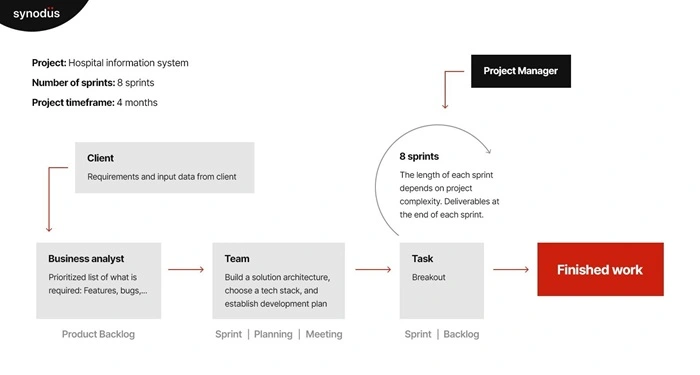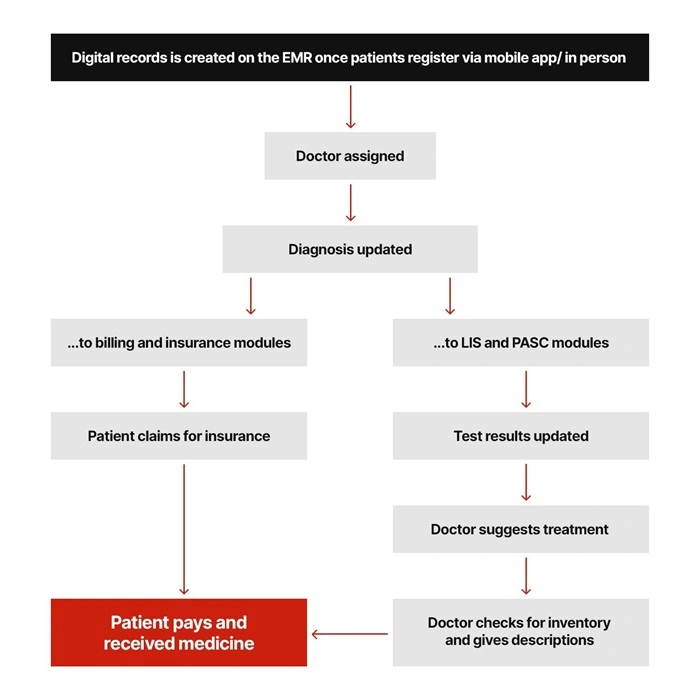Current state of HIS adoption in SEA and APAC
To understand how a hospital information system is used in APAC and SEA, we dug into many healthcare industry research and regional regulatory studies. Here are some takeaways:
- Developed countries in APAC, such as Singapore, Australia, Japan, Korea, and New Zealand, have actively utilized HIS to build a comprehensive patient data system.
It has become a part of their routine. Now, hospitals seek to integrate telehealth, AI, blockchain, or predictive analytics to make it more advanced (which we will cover later). - Developing countries in APAC, such as Vietnam, Thailand, Malaysia, or the Philippines, are still newcomers.
Despite knowing the benefits of HIS, most are skeptical about investing due to the high cost, lack of IT talent to manage it, unclear ROI, and inability to adapt to regional regulations. This leads to a low adoption rate. While major facilities might have implemented the system, smaller ones are still out of the game.
Because of this, their requirements for a good HIS revolve around IoT infrastructure, data management, mobile apps, and telehealth.
In Malaysia, only 3% of healthcare facility use HIS, EHR or both.
Hospital information system case study: An implementation that boosts operation efficiency up to 70%
Project overview
| Services used | Team size | Timeframe | End-users |
|---|---|---|---|
| Custom software development Dedicated team | 7 members | 4 months | For HIS: Doctors, administration staff For mobile app: Patients |
Being a long-standing medical institution in Vietnam, Military Hospital 110 serves nearly 1,500 outpatients and a maximum of 500 inpatients daily. The facility focuses on treating the local and military personnel, hence being trusted by the people with top-notch care and skillful staff.
As our client strives to uphold its high standards and quality of care, it stumbles under a growing number of patients, which causes many operational challenges.
Late response, sluggish treatment, long wait time…, what happened?
Despite having 500 healthcare staff, the facility received many bad reviews for its slow response to patient requests. The staff constantly lost track of their patients’ information, which not only tired them but also made the hospital visit a hassle for patients. Our client understands they need to maintain uninterrupted service provision.
This scenario is now the past of Military Hospital 110, but it’s still a daily part of life in many Vietnamese and SEA hospitals.
Are you having the same problems?
Our process of developing the hospital information system
Coming to us, our client had 2 requests:
- That we must develop a smart HIS system with EMR, inventory, and patient-facing modules that can digitize their facility into a paperless and fast-paced one.
- Being a mid-sized healthcare facility, they required a balance between quality and cost.
And here’s what our development process looked like over 4 months:

Our team consisted of:
- Business analyst: To understand our client’s nature and unique requirements.
- Project manager: As our client wanted a dedicated team, we assigned a PM to manage seamless execution and code quality.
- Developers: Including both front-end and back-end to build a mobile app for patients and HIS system for the healthcare facility.
- UX/UI designer: He made sure the system was friendly and easy to use for users of all demographics.
- Testers and QAs: To make sure the application is usable, error-free, and safe.
Dealing with high-level requirement and a request for cost-effectiveness, our development was based on 3 approaches:
- We chose a packaged solution – a pre-built HIS architecture that we made – to solve basics tasks of every hospital. This way we can optimize development time and hence save our client’s budget.
- We added customization when it was needed to make the HIS flexible and adaptive to Vietnamese regulations and our client’s internal processes.
- We adopted the Agile methodology and split the projects into 8 sprints to ensure on-time and quality delivery. We completed every sprint before moving on to the next.
A look into the HIS
This is one of our many successes of hospital information system case studies. Thanks to a clear development plan and agile-driven methodology, a robust HIS and EMR was built.
(1) The core system
These are the functions that every HIS should have to make it usable and effective. Most of these features are from our packaged architecture, specifically:
- EMR to store patient records, enabling easy access and retrieval.
- An automated appointment scheduling feature to reduce wait time and eliminate long-line at the reservation.
- Bed and ER management with real-time updates for inpatients data.
- Billing and insurance management to reduce claims.
- Medicine and equipment management that effectively track hospital inventory, making sure there’s always enough supply when needed. The system also supports our client in optimizing asset utilization, distribution, and maintenance costs.
- Separated dashboards for doctors and for administration staff.
(2) Here’s when our customization comes in clutch
Using an extensive tech stack, we tailor some advanced modules to make the HIS entirely fit our client’s requirements, notably:
- A mobile app for patients and doctors: The mobile app is designed for Vietnamese users. It has 2 choices of languages and an interface that is familiar to Vietnamese. Patients can access medical records, schedule appointments, and communicate with health experts from 110 Hospital remotely.
- Using IoT, the EMR can be connected to a LIS (laboratory information system for test results) and PACS (picture archiving and communication system for scanning and X-ray results) for a streamline patient’s data across the facility.
- The EMR must adhere to Vietnamese regulation on data protection. It must also contain information like Citizen ID, social security, insurance number, and other data supporting Level 2 electronic identification system of the country.
- A training management module where staff can share their knowledge and support career development. This system also bolsters telemedicine.
- Integrated data analytics system showing how the facility performs, current number of patients and many more.
To understand how the hospital information system works in real-life, here’s the visualization:

The results
Post-deployment, we also provided training to all healthcare staff and conducted many tests on data transferring across departments.
Thanks to the hospital information system, our client recorded lots of changes:
100%
adoption across departments and staff
70%
boost in operational efficiency thanks to automation and centralization
85%
of reports and forms are digitalized, saving tons of money and time on paperwork
< 2
minutes is the average time a patient waits for their medical records to be synchronized
90%
decrease in incidents such as late response, disparate data, wrong diagnosis, and frustrated patients
100%
connectivity with LIS, PACS according to HL7, ISO and HIPPA standard
And, of course, there are many underlying positives as well.
When we talked to doctors and staff at Military Hospital 110, they were happier than before. They can now spend more time with patients instead of stressing themselves out with paperwork. Communication is smooth like butter since everything is shown through digital records. Interaction with patients is insightful and genuine.
We have worked with 30+ facilities and 10,000 healthcare staff
What we can learn from the hospital information system case study
Building a HIS isn’t an easy ride. To make it a successful deployment, you need careful execution and qualified developers.
Other than that, here are the elements that contributed to our winning hospital information system case study:
1. Choosing the right adoption strategy: Use an off-the-shelf HIS, build from scratch, or adopt a packaged solution that allows you to customize, as our client did? One wrong move will cost you time and money, as you don’t want to switch back and forth between strategies.
| Approach | OTS/ SaaS HIS | Build from scratch | Packaged solution |
|---|---|---|---|
| Best for | Small facility with limited budget Want a HIS that solve simple administrative and data-related tasks | Large facility with complicated requirements that integrate AI, data analytics, blockchain, etc. | Small to mid-size facilities that want a robust HIS with customization to best serve their facility. Cost-effective than building from scratch yet having more flexibility than SaaS HIS. |
2. A decent HIS should be able to serve:
- The hospital: It should be scalable, comply with regional regulatory, protect sensitive data, and open to integration with third-party system.
- The patients: It should be easy-to-use for any patients and support the social standard (for example, supporting Islam rules is a bonus for Malaysian).
3. A winning HIS relies very much on the expertise of the developers. Either hiring an in-house team or working with a partner like Synodus, remember to be mindful of their experience. You should choose someone who has worked with HIS before and can balance quality and your budget. Finally, avoid these red flags as much as possible.
4. Post-development is extremely important. Make sure every staff is on board with the use of HIS and knows how to utilize it. You should establish training courses and create maintenance plans to constantly check and update the HIS.
Upcoming trend on using HIS and Healthtech
Driven by technological advancement, hospital information systems will no longer rely on mere IoT or Cloud infrastructure. It will adopt new technology, expand its own capabilities and nurture the growth of HealthTech.
Your facility might not in demand of these technology or features, but it’s necessary to keep an eye on:
- Support telehealth, telemedicine and remote healthcare. Your patients can create their own digital records from afar, without going to the hospitals. Then can get direct consultation with doctors through mobile app and every diagnosis data is stored real-time under the EMR
- The use of AI, ML and predictive analytics to support accurate diagnosis and personalized treatment plans.
- Many countries are actively planning to build a national healthcare data system. If you are one of them, watch out for integration needs and support of mHealth.
- Wearable health devices integration to gather data for your HIS and remote healthcare.
- Adopting AR/VR or 3D image to support health training, remote diagnosis and many more.
- The use of blockchain in healthcare still has lots of questions, but it’s worth a watch.
As one of the leading healthcare developers in APAC at Synodus, we actively embrace this new technology and are finding a way to craft your best-suited solution. This hospital information system case study isn’t our only pride; we have also adopted data analytics for healthcare, leveraged AI for image scanning, integrated wearable devices, and used telehealth.
Wrapping up
We hope that our hospital information system case study will help you learn how to build an HIS, how to make it serve your needs, and which development strategy to focus on.
How useful was this post?
Click on a star to rate it!
Average rating / 5. Vote count:
No votes so far! Be the first to rate this post.




